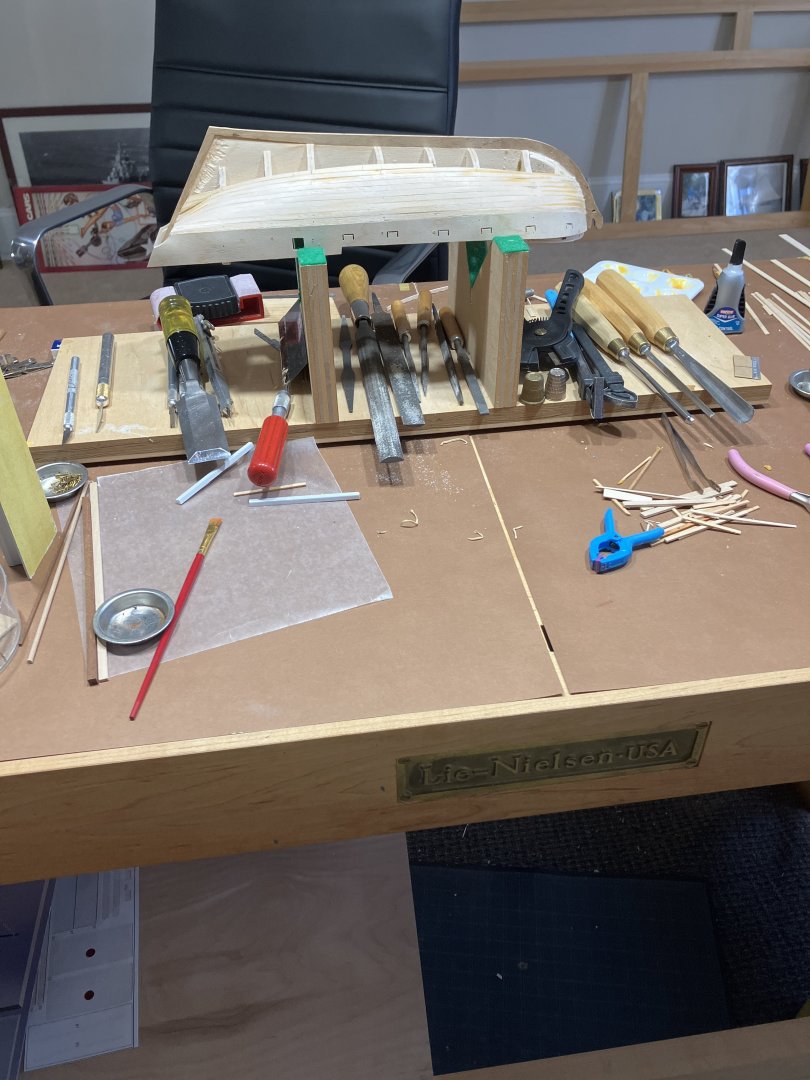-
Posts
733 -
Joined
-
Last visited
Content Type
Profiles
Forums
Gallery
Events
Everything posted by ERS Rich
-
-
Always a good time watching your work. Thanks
- 161 replies
-
- Red Jacket
- Marine Model Company
-
(and 2 more)
Tagged with:
-
Hardly a newbie! Welcome and good luck with your project. -Rich
-
Good job, looking forward to what’s ahead…..
- 61 replies
-
- First build
- Cutter
-
(and 2 more)
Tagged with:
-
“Clinker” happening means the width of the plank needs to be reduced, or tapered, towards the stem. The taper starts about the third bulkhead aft of the stem, the plank width will end half the width or less at the stem. At first you can get away with not doing it, it will catch up to you. Find one of the many postings on this site to see how to do it. My Constitution build log talks about it. Nice work, so far, good luck.
- 61 replies
-
- First build
- Cutter
-
(and 2 more)
Tagged with:
-
Keep going! Sand that wood filler until it is smooth and feathered in. When filling seams feel free to mask off each side so extra filler is on the tape. Makes the sanding job easy. Consider the lower hull needs to be completely smooth, no humps or bumps, or “stair steps” between planks. Look into how to use a card file. Good luck.
-
Howdy! Good luck with your projects!
-
Good point about hardwood, I was thinking about pine. The walnut strips can be grainy, shellac may reduce it, but it will probably look good unsealed. If you go that way interested in seeing how it looks. I’ve never used the Walnut strips to plank, did not want to deal with the brittleness, I think some soak them which helps with the knife cuts, cut with the grain rather than against. Check out Mr Hobby Mr Metal Primer, I’ve brushed it on metal cannon barrels and painted with Vallejo acrylic paint. Paasche Talon is my go to brush, a little less expensive than an Iwata. Most common airbrush problems are due to cleanliness or paint not thin enough. Vallejo air solves the second problem, the first is knowing how to disassemble and clean the brush. Anyway now I always go with blackening because you skip the priming step. Nice talking about this stuff, I’ll hang back and see what happens.
- 61 replies
-
- First build
- Cutter
-
(and 2 more)
Tagged with:
-
One more thing, the way you soaked and clamped the bulwark around the jar is spot on. The same can be done with hull planks. Cheers
- 61 replies
-
- First build
- Cutter
-
(and 2 more)
Tagged with:
-
Late to the party. Your ship looks good. The clinkers happen when the planks at the stem have not been tapered enough and are pulled towards the keel to fit. It’s ok. Look into using small files to shape wood. Get round, half round and flat. More precise than sanding, and faster. Fill in the clinker gaps with sandable wood glue and shape the hull with the files. Paint. Sealing the wood is a must. Shellac works well and dries fast. Make up some board samples, try one coat of shellac, then paint. Two coats shellac then paint. The shellac coats slowly fill in the grain. Yes, the thin airbrush coats show the grain nicely. You are doing good work. Keep going. In the end hull imperfections are practically unnoticeable when the ship is mounted or on the stand. Remember if it looks good from a foot away it’s ok. The rigging on this model dominates, most people will notice and be impressed with the rigging and the deck. Make choices to your taste. Your family and friends are not going to say your shade of Ochre is off. Good luck. -Rich
- 61 replies
-
- First build
- Cutter
-
(and 2 more)
Tagged with:
-

Planking disaster
ERS Rich replied to sgrez's topic in Building, Framing, Planking and plating a ships hull and deck
Consider a lot of putty means painting the hull. The putty texture will not match wood grain. This means sealing the wood, prime, then paint. Good luck, -Rich -

Planking disaster
ERS Rich replied to sgrez's topic in Building, Framing, Planking and plating a ships hull and deck
Good job so far. Do you want to take it to the next level, beyond the instructions? Start tapering the plank widths. Consider planking 4 bulkheads at a time - it’s easier. Consult the How to Plank references here on MSW. Get into plank tapering. Good luck! -Rich -
Hi, Nice effort and glad that the work continues. Some thoughts hope they help. As you know walnut is brittle, rather than a knife use a chisel. As you found the grain makes the knife waver during the draw. You need a very sharp chisel. I use a 1” bench chisel. Mark the plank with say a line along its length. Put the walnut on a block of wood and put the chisel on the line and press down to make the cut. Do you understand wood grain? How to make relief cuts? Checkout Youtube. Noticed in the planking post something about full length planks - single plank from bow to stern. It’s harder this way. Try planks that span 4 bulkheads - it’s easier to taper. Getting the correct taper on a full length plank is very difficult and if you make a mistake at the end - bummer. Also smaller walnet planks would be easier to work. Do you have small files? They make the job evening up the gunport openings easier. And the paint. Is the wood sealed before painting? Pine wood stain or better shellac are good choices. Good luck, -Rich
-
An example of the normal difference between the Plans, the ideal, and what happens in the field…. Good luck with your project.
- 28 replies
-
- Pillsbury
- Clemson-class
-
(and 1 more)
Tagged with:
-

Worst Planking Job Ever
ERS Rich replied to rhephner's topic in Building, Framing, Planking and plating a ships hull and deck
The “clinkering” (bulges?) are caused by pulling the plank end down towards the keel to get it under the neighbor above. Instead, mark where the plank overlays its neighbor above and taper the plank. You can’t bend a plank down towards the keel. You can only lay a plank straight down on a bulkhead, slide it up slightly to press against the installed plank above, or twist a plank to say run up the stern. Very little force should be needed to install. Make sure a plank is properly shaped before installing, then it will be easy to install. Ideally if properly shaped there will be no gaps. If a lot of gap filling and sanding is needed, something is wrong, look at the books and videos, study the techniques, and find out what works for you. Good luck! -

Planking
ERS Rich replied to sgrez's topic in Building, Framing, Planking and plating a ships hull and deck
Notice this plank (wale) is probably the same width from bow to stern, and probably easiest to install. Planks from the wale above probably are not tapered (width reduced) amidships, and at the stern; and probably are towards the bow. Think of a picture frame when considering planking from the Wale to the Keel. This first plank is the top of the frame, the Keel the lower frame, and the stem and stern post the sides. The skill is understanding where the lower planks need to be tapered (width reduced), and doing it. There are many postings in this site, and books have been written on how to do this. From my experience AL kit instructions do not show this. Hence builders of these kits, usually beginners, may not get the results they imagine. Good luck. -
Welcome, good luck with your projects.
-
Try soaking the planks longer, place the end of the plank on a jar of water. Try 5, 10, 15 minutes or longer. If the wood swells, soak less, if not soak more. Pine resin will inhibit water absorption. My plank bender came with a wooden jig. Place the plank in the jig, press down with the iron to form the plank along the jig. The plank will probably partially spring back, so the process may need to be repeated. There are many ways to do this job. Find what works for you. The electric bender can work, but it’s time consuming. For mass production, I’ll soak 10 planks, end in a jar, overnight, then use clothes pins to hold them around a round plastic container. Let them dry overnight. Also swelling for me, hasn’t been an issue. Sometimes the grain swells, if so, let the wood dry completely, give it a light sand. Haven’t had a problem with swelling changing the plank dimensions. Good luck with it. -Rich
About us
Modelshipworld - Advancing Ship Modeling through Research
SSL Secured
Your security is important for us so this Website is SSL-Secured
NRG Mailing Address
Nautical Research Guild
237 South Lincoln Street
Westmont IL, 60559-1917
Model Ship World ® and the MSW logo are Registered Trademarks, and belong to the Nautical Research Guild (United States Patent and Trademark Office: No. 6,929,264 & No. 6,929,274, registered Dec. 20, 2022)
Helpful Links
About the NRG
If you enjoy building ship models that are historically accurate as well as beautiful, then The Nautical Research Guild (NRG) is just right for you.
The Guild is a non-profit educational organization whose mission is to “Advance Ship Modeling Through Research”. We provide support to our members in their efforts to raise the quality of their model ships.
The Nautical Research Guild has published our world-renowned quarterly magazine, The Nautical Research Journal, since 1955. The pages of the Journal are full of articles by accomplished ship modelers who show you how they create those exquisite details on their models, and by maritime historians who show you the correct details to build. The Journal is available in both print and digital editions. Go to the NRG web site (www.thenrg.org) to download a complimentary digital copy of the Journal. The NRG also publishes plan sets, books and compilations of back issues of the Journal and the former Ships in Scale and Model Ship Builder magazines.




